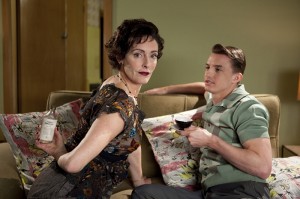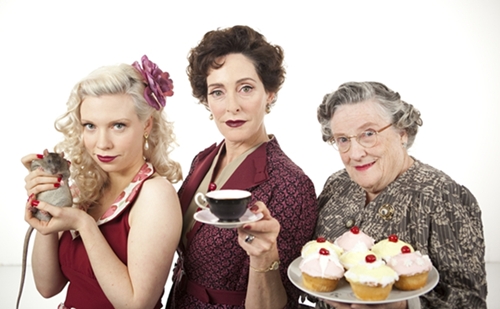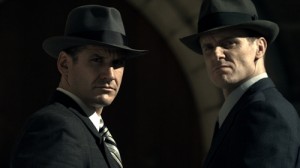Sydney, Australia’s inner suburbs in the early 1950s seem an unlikely setting for a slew of cold-blooded murders. But many families were plagued by poverty, poor housing conditions and an epidemic of rats (there are stories of parents sleeping with their children to protect them from being bitten during the night). And, for several women, apparently unhinged or at the end of their ropes, eliminating a tiresome man or two topped their to-do lists, along with cooking, cleaning and killing rats of the rodent variety.
Thallium – the active ingredient in rat poison – was the perfect murder weapon. It had no color, taste or smell and it produced a gradual demise rather than sudden death. Police estimate that hundreds of people died from thallium poisoning in the late 1940s and early 1950s. Banned in the rest of the Australia and most of the developed world, thallium was freely available in Sydney.
“Recipe For Murder,” a film by first-time writer/director Sonia Bible, tells the true story of three notorious poisoners: Yvonne Fletcher, Caroline Grills and Veronica Monty.
Yvonne Fletcher, 29, a blonde good-time girl, was accused of killing two husbands. Next to be charged was Caroline Grills, 63. She was accused of being a serial killer after four members of her family died in suspicious circumstances.
The most scandalous and sensational case was Veronica Monty. The 45-year-old was charged with attempted murder of her son-in-law, Bobby Lulham, a famous Australian Rugby league player, with whom she had an affair.
“Recipe For Murder” follows the detectives cracking the cases, the media and the women standing trial. The film combines archival footage, film-noir re-enactments, interviews with witnesses, a musical score from “Animal Kingdom” composer Antony Partos and narration by Dan Wyllie. There are no plans for a theatrical release, but you can buy the film here.
I recently chatted with Sonia via email.
Film Noir Blonde: It’s such a fascinating but little-known story. I understand you became aware of it in 2003 at an exhibition in Sydney called “Crimes of Passion.” What was it that drew you to these murders?
Sonia Bible: The story of the thallium murders was a piece of history that I didn’t know about, and it was also a period that I was fascinated with visually. With three real-life femme fatales, film noir was the perfect fit for the stylized re-enactments.

Anne Looby as Veronica Monty and James Anderson as her son-in-law Bobby Lulham, a famous Rugby player.
FNB: At what point did you decide to make a film and profile the three women?
SB: Yvonne Fletcher, Caroline Grills and Veronica Monty were the three most notorious women of all those charged with murder by thallium. Their stories also intersected in interesting ways at different points in time.
FNB: Thallium poison, though it caused a painful death, was a silent, surreptitious killer. Was there something about that approach that you think appealed to women?
SB: The use of poison is traditionally a woman’s crime. It’s been around for a long time and is more often used by women. Men tend to use their fists or weapons to commit violence against others.
FNB: At the same time, thallium’s “advantages” may have held equal appeal for men, correct?
SB: No. Men used thallium in Sydney at the time to poison others or themselves, but women committed the majority of thallium poisoning cases. Women didn’t have any other means to control their circumstances at the time. Also the control of rats was considered a domestic duty to be carried out by women. Women had more understanding of the poison and ready access to it.
FNB: Toward the end of the film, we learn that the police investigators working on these cases (Don Fergusson and Fred Krahe) turned out to be corrupt. Do you think they may have targeted women perpetrators as a way of making an example of them or even to advance their own careers?
SB: No. Although Krahe and Fergusson went on to be corrupt, their investigations into the thallium murders were thorough and professional. Yvonne Fletcher was the first person to be charged with murder by thallium and it wasn’t because she was a woman. It was because she murdered two husbands in a very cruel way. Nobody even knew that thallium was dangerous to humans until Krahe and Fergusson cracked that case.
FNB: What was your biggest obstacle or challenge in making the film?
SB: The biggest challenge in making the film was the production budget. We were doing period drama on a documentary budget, and always looking for creative solutions and innovative ways of getting around the budget constraints.
FNB: What kind of reception have you had from the film, both at home and elsewhere?
SB: “Recipe For Murder” achieved really high ratings when it screened on TV in Australia. It also got rave reviews in the Australian media leading up to the screening. The film won a Silver Hugo award at Chicago International Film Festival 2011 as well. We were all thrilled with the enthusiastic response.











![Melancholia_320[1]](http://www.filmnoirblonde.com/wp-content/uploads/2011/05/Melancholia_3201-150x150.jpg)





From FNB readers